Hunting eastern coyotes isn’t for the faint of heart. These massive creatures can sneak within yards of even the most skilled woodsman. They also possess an uncanny ability to detect humans, and inhabit some of the roughest terrains a hunter could enter.
If you want to take a dog as large as Mitchell Seabury’s 54-pounder (pictured above), throw away your West Coast notions of 500-yard shots made on perfectly still coyotes. To hunt eastern coyotes, you’ll have to be fast on that gun and willing to slog through deep snow and miles of woods. If you get lucky, however, you’ll also need to be strong enough to carry your 50 lbs or more trophy back to the truck.
Hunting eastern coyotes where they live.
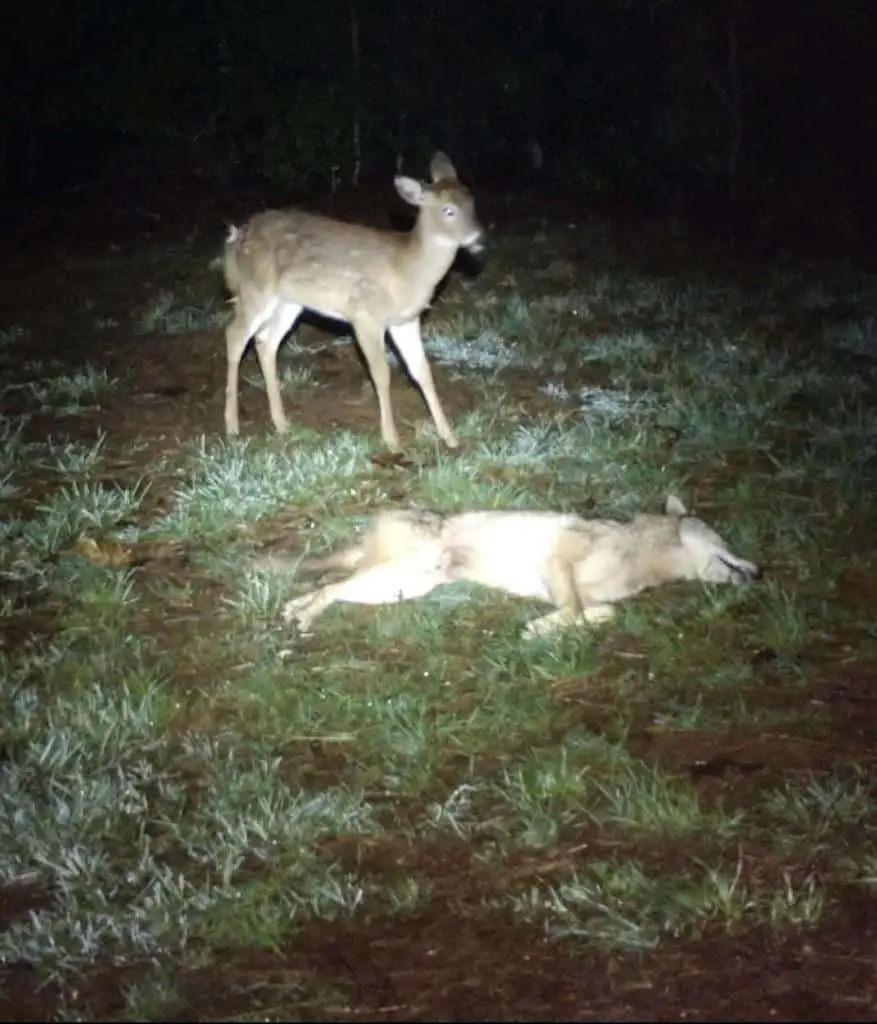
Most of your success when you hunt eastern coyotes will boil down to knowing where they live. To find an eastern coyote’s home you have to know what they eat and where that food is found in abundance.
Despite the occasional fawn, eastern coyotes thrive on rabbit. Rabbits are herbivores. The plants, leaves, weeds, and grasses they live on are found in open grassy areas, old fields, and clearings. Brian Rush of Rushcustomcallers.com calls this area where rabbits find food, water, and shelter,“rabbit-tat.” Rabbit-tat is also the perfect home for field mice, voles, insects, and birds.
To an eastern coyote, rabbit-tat is more than a smorgasbord, it’s a place to live in and raise a family. If there’s a stream or watering hole nearby, during pup rearing season this will be the hottest coyote hunting spot you’ll ever make a stand on. Locate a coyote den with pups near rabbit-tat and you can literally predict the timing and exact locations of the adults.
Related: Using scat and tracks to scout for coyotes.
Related: How-to-locate-a-coyotes-spring-and-summer-den/
Hunt for sign, before you hunt eastern coyotes.
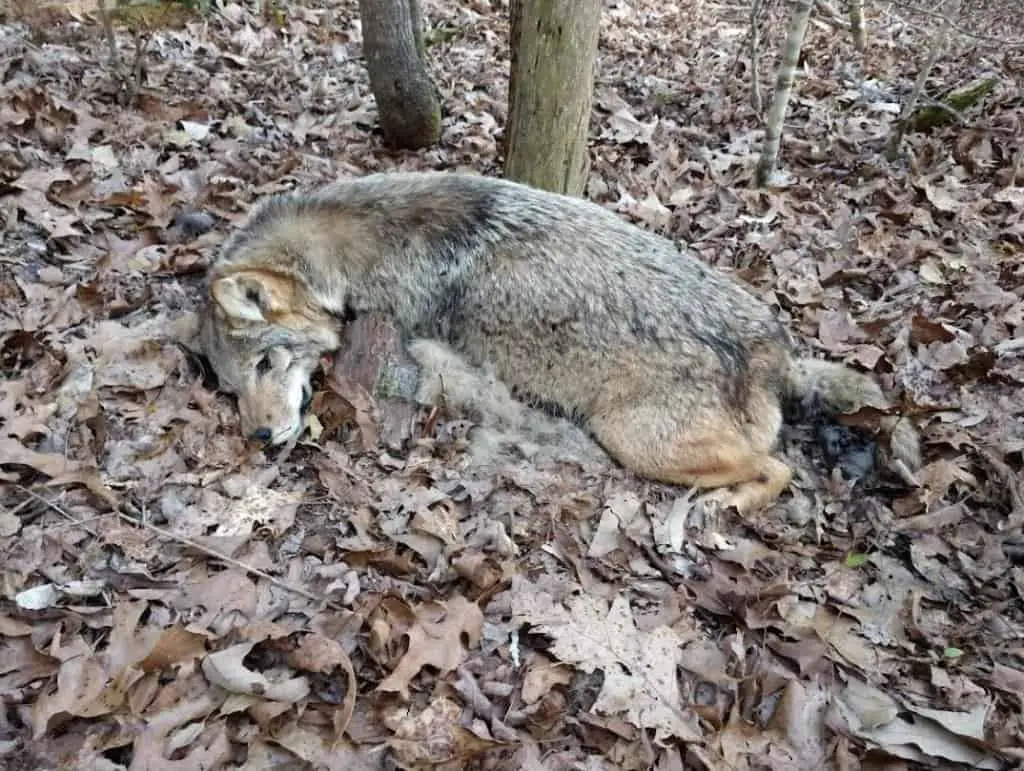
Once you’ve found the rabbit-tat, it’s time for a bit of recon. There’s two ways to recon a potential hunting area to look for sign; the fast and easy scan or the slow and hard slog.
The fast and easy way to locate eastern coyotes.
Grab a red scanning light and caller and wait until just before dark. Now, just like you would on an actual stand, give the area a good 15 minutes to settle down after your arrival. Now make any coyote howl you like and quickly give the land a thorough scanning.
If there are any coyotes in the field, they should be looking in your direction and your light will turn their eyes into little balls of fire. If there are more distant coyotes, you may get a response—especially if there’s an active den nearby or a resident coyote objects to your intrusion.
If you don’t spot any eyes or get howled at, wait 30 minutes and try it again. If you see or hear coyotes, you’ve found a great spot to make your next stand. If you don’t, this may still be a great place for a secondary stand in the future.
The slow and hard slog: Using sign to find eastern coyotes.
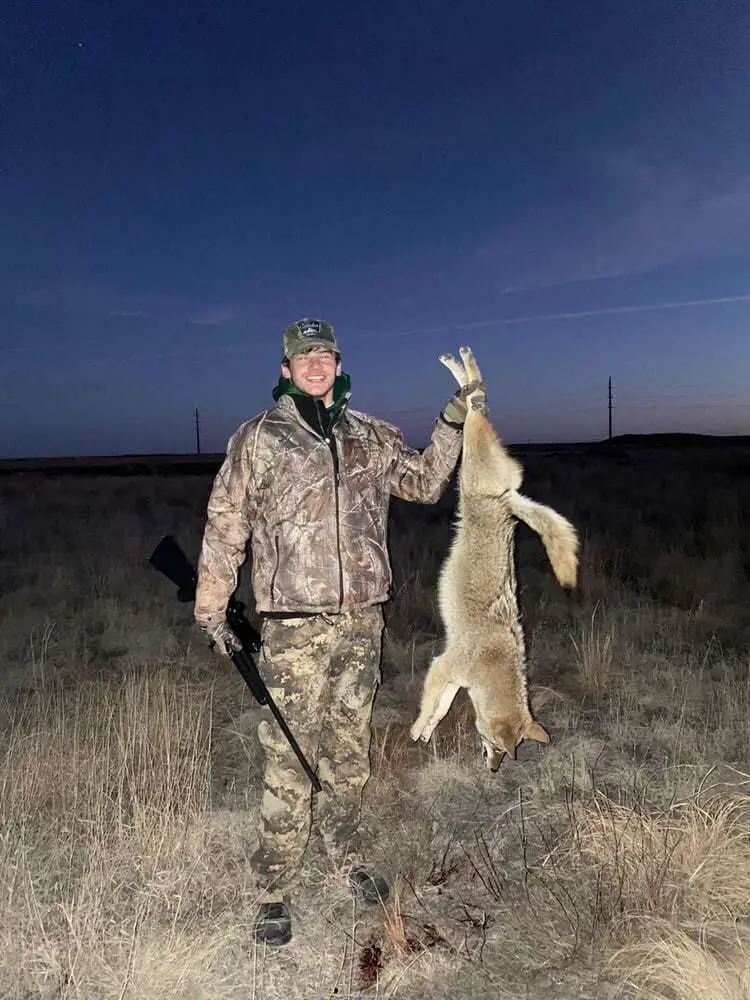
Eric Turner of Kansas with one of the several 50 + pound coyotes he’s taken.
No tools required for this method, but you’ll need a few hours and you’ll wear out a little shoe leather. The slow and hard slog is a daylight job. You’ll be methodically walking the field you’ve selected, looking for coyote scat, tracks, and dens.
Scat
Eastern Coyote scat (dung) is often dark and color, lightening as it ages. Coyote scat looks much like what Fido leaves behind. It’s three to four inches long, about an inch in diameter, and tapered on both ends.
Summer coyote scat is lighter in color and will contain the seeds, berries, and fruit remnants they supplement their diet with during the season. Winter coyote scat is much darker and will have partially digested bone and fur matter.
Related: Using scat and tracks to scout for coyotes.
Tracks
Fresh tracks are eye-catching and positive proof of coyote activity in your potential hunting area. The first thing you should note is the shape of the trail they leave behind. A domesticated dog probably left a wandering trail behind. A narrow, straight path is evidence that a fox or coyote made the sign.
Related: https://www.greenbelly.co/pages/animal-tracks-identification-guide
Dens
Where hunting coyotes during pup rearing season is legal, an active coyote den is the best sign you can find. Adult coyotes will not leave an active den unless severely pressured. Outside of pup rearing season, however, coyotes do not use dens.
Most coyote dens are easily recognized. They are often nothing more than a two-foot-wide hole with excavated dirt piled up in front of the entrance and scores of tracks leading into and away from it. If your timing is right, it might even have a litter of pups playing at the entrance or just outside of it.
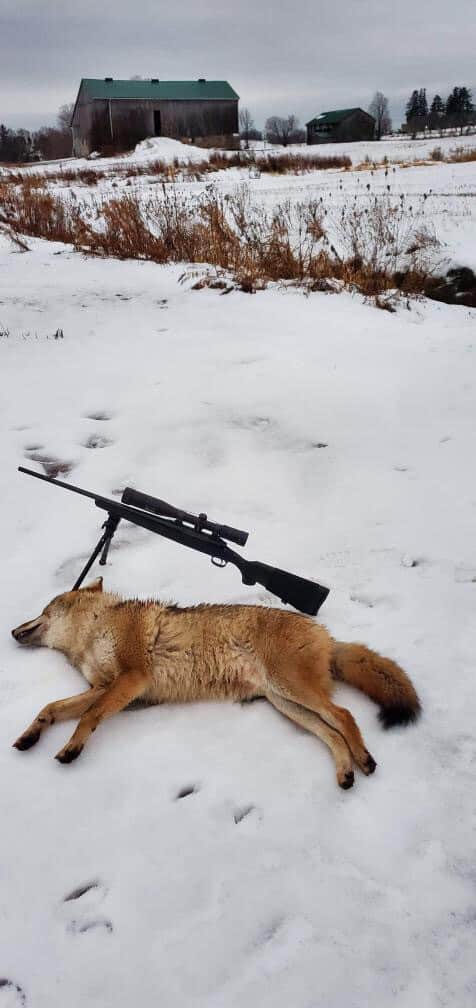
If you find do not find evidence of coyote activity using the slow and hard slog, skip it this season or toss it on the end of a long night of hunting.
The secret sweet spots for hunting eastern coyotes.
Outside of rabbit-tat, there are three great places to catch an eastern coyote. While all three have different qualities that are attractive to coyotes, the each provide two essential elements every coyote needs: nearby cover and easily recognized territorial boundaries.
Mowed fields, fresh cut hayfields, and recently harvested farmland.
These areas naturally draw in eastern coyotes like metal filings to a magnet. A few acres of such land will often crawl with visible rodents and hum with their squeaks.
Eastern coyotes have learned that the very scent of mowed grass, harvested corn, and cut hay means an fabulous meal has been prepared for them. For the next two weeks, they will both hunt and haunt these areas pouncing, stabbing, and digging out dozens of mice and voles every hour.
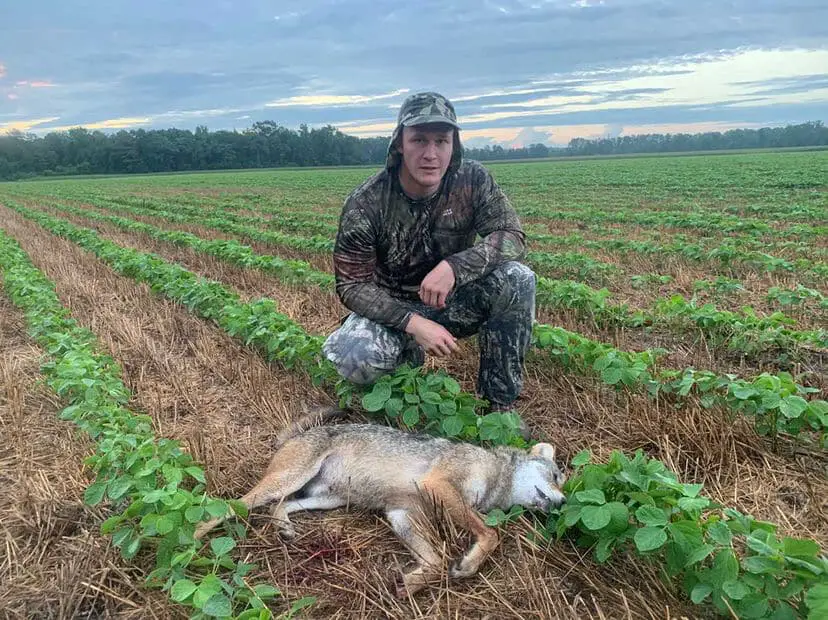
Daytime hunting is possible, but eastern coyotes, unlike deer, never get comfortable around areas with normal human traffic. After sunup, you’ll need to carefully set your caller and decoy up without being seen. To cancel out their natural fear of large, open spaces, try using a fawn decoy. The promise of a larger, easy meal may be enough to lure them out.
Hunting eastern coyotes in these locations is best done at night. The coyotes will often be spotted before they break cover as eyes slipping through the cover around the fields. When they enter the field itself, the low cut vegetation will make for some excellent shooting.
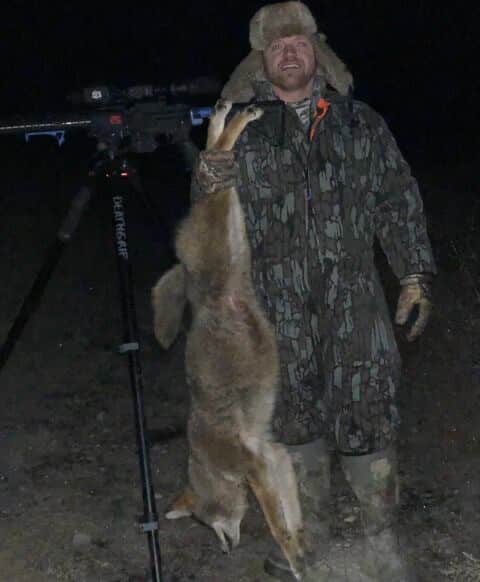
Getting permission to hunt such land isn’t always as easy as it would seem. Crop owners sometimes consider coyotes a benefit. After all, deer ruin crops and eastern coyotes kill deer.
Unless there’s some livestock to protect, there’s little incentive for a farmer to grant a predator hunter permission to use their land.
Logging roads, utility right of ways, and streams.
For the eastern coyote, these easily traversed paths offer long stretches of visibility and rapid travel. Most coyotes will first peek out from nearby cover and sniff the wind while looking around.
Once satisfied it’s safe, they will trot straight down the roads and right of ways, stopping only to scent mark if the path marks a territorial boundary. If you’ve found a well traveled path, the scat and tracks they leave behind will be frequent and fresh.
With streams, the coyote will typically stalk their way along the bed, kicking up frogs, rodents, and other small game. If there is a drawback to hunting coyotes in these areas, it’s the possibility that they represent an uncrossable boundary.
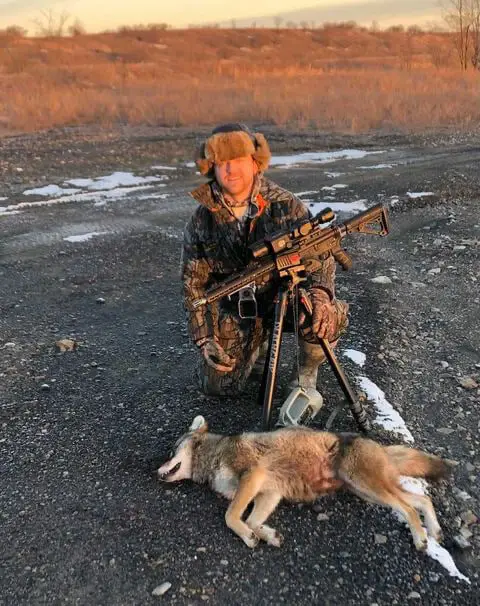
Resident vs. nonresident.
Resident coyotes do not kill trespassers, but they give them a hell of a thumping until they submit. Transient coyotes (those in search of a territory of their own) and resident coyotes of neighboring territories will not be easily convinced to cross a boundary line.
Watch out for human traffic!
Safety is another concern. Repair crews, loggers, and other folks use these paths. Make sure you adhere to all the hunting safety rules.
Calling logging roads, right of ways, and streams to hunt eastern coyotes.
Calling logging roads, right of ways and streams during the day is more productive if you use a decoy. The same visibility that helps the coyote, helps you. A caller alerts the coyote to the potential meal and the clearly visible decoy confirms it.
In the winter, and where you can legally do so, breaking a trail through the snow with an ATV or snowmobile will turn these paths into superhighways.
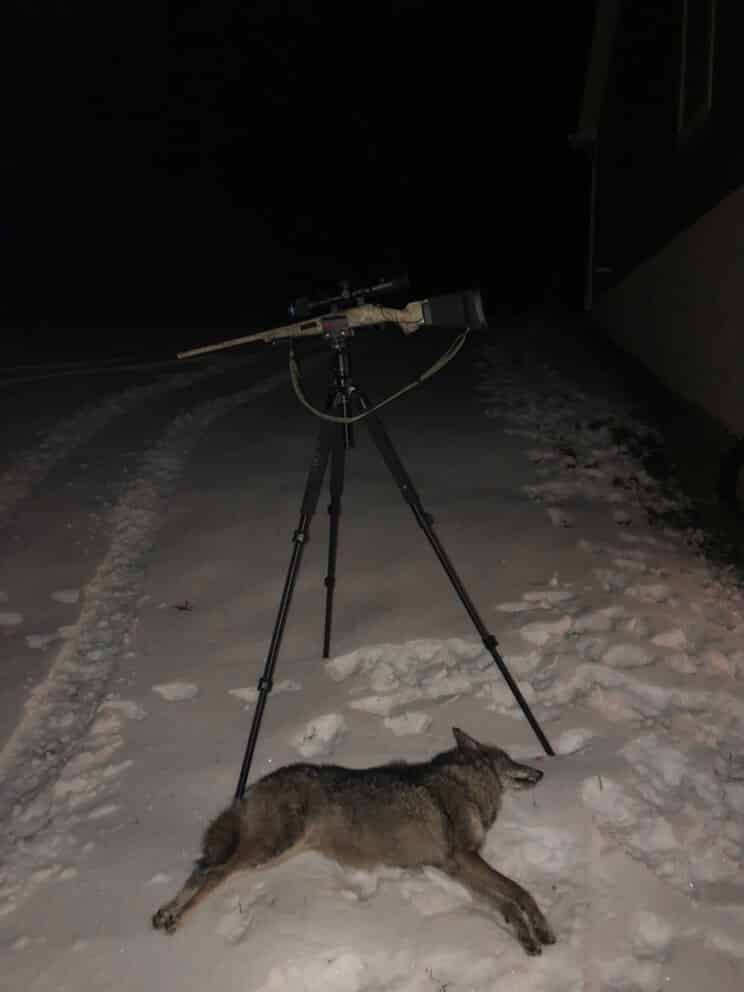
When you call these highways recognize these are travel lanes, not actual habitat for an eastern’s prey. During the day a coyote won’t find a target of opportunity (decoy) unusual. At night you will get better results using coyote vocalizations.
Start with an inoffensive female howl. Even a transient will be curious enough to check it out. Next, up the level of aggressiveness and challenge the locals to come out and defend their land.
A strange male coyote howling on a resident coyote’s private lane will bring more action than the sound of trespassing ATV’s on Karen’s 10 acre wood lot.
Unique tactics for hunting eastern coyotes.
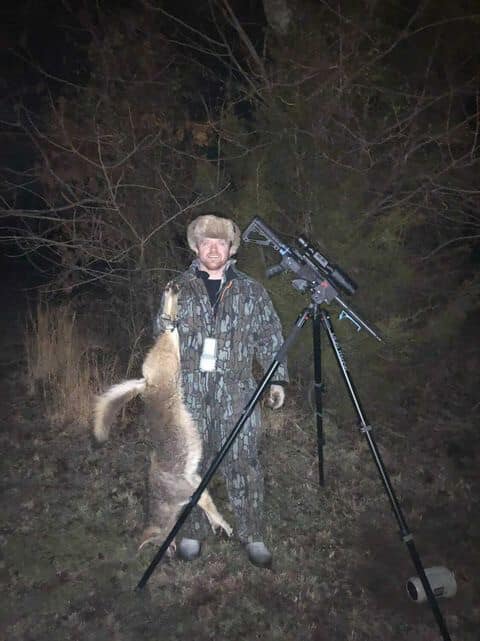
Hunt eastern coyotes where you can see them.
You will be hunting eastern coyotes in places that can be best described as “not camera friendly.” Rough hilly terrain, smaller lots, and thick stands of trees. A cameraman will have the same difficulty as the hunter, a completed block view until the moment the coyote appears. And eastern coyotes often appear surprisingly close—making this a two gun sport (shotgun/rifle) for many predator hunters.
The lack of expansive vistas like those out west can be a real problem for many new eastern coyote hunters. New hunters never see many of the coyotes that come close enough to be taken.
Some will stay on stand for an hour, only break stand and then notice the fresh tracks in the snow 10 yards behind them. Others will suffer the frustration of watching an eastern coyote dart from tree to rock to tree, seemingly aware of the hunter’s presence and never offering a clear shot.
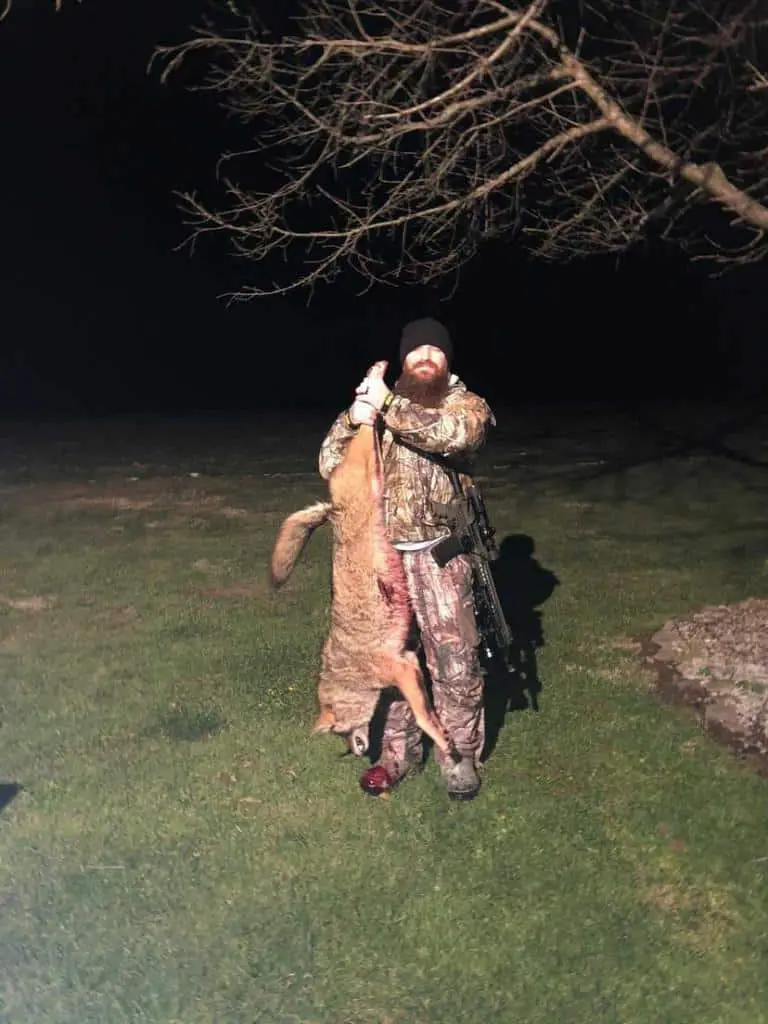
Brian Scott, Ohio. The Big Bald Guy routinely harvests Monster sized coyotes.
Experienced eastern coyote hunters spend some time during the day studying the land they want to put a stand on. They know what the neighboring properties consist of, determine the direction the coyote will likely approach from, and set up in a place that lets them have a constant view over any hills, draws, or rises.
Use longer calling times when hunting eastern coyotes.
Battery manufacturers should sponsor anyone who hunts eastern coyotes. Lights aside, more on them later, you’ll burn more batteries in a month calling eastern coyotes than a western coyote hunter burns all season. That’s because eastern coyotes can take 2-3 times the time to respond to a caller.
The Northeast is neither flat nor open. Many geographic features effectively obscure a coyote’s approach until he is nearly in your lap.
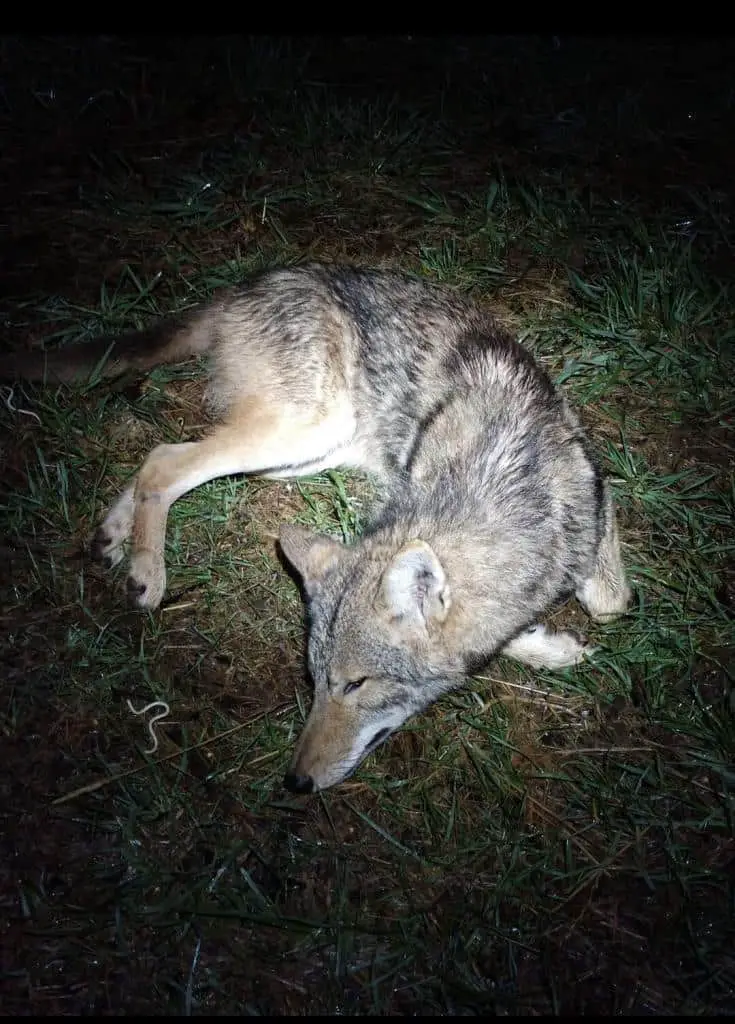
Those features, especially ponds and swamps, mean it may take a coyote more than 45 minutes just to get to your stand. This is rugged country that will test any predator caller’s patience, yet it’s the patient hunters who invariably win at this game.
There’s a darn good reasons for this. Simply put, there are fewer eastern coyotes than western coyotes.
Related:
One study indicated there might be as few as 1.4 eastern coyotes for every five square miles. In the West, the number of coyotes jumps as high as 5-10 per square mile. So it stands to reason that any responding coyote may have traveled for miles to reach your caller with fewer coyotes.
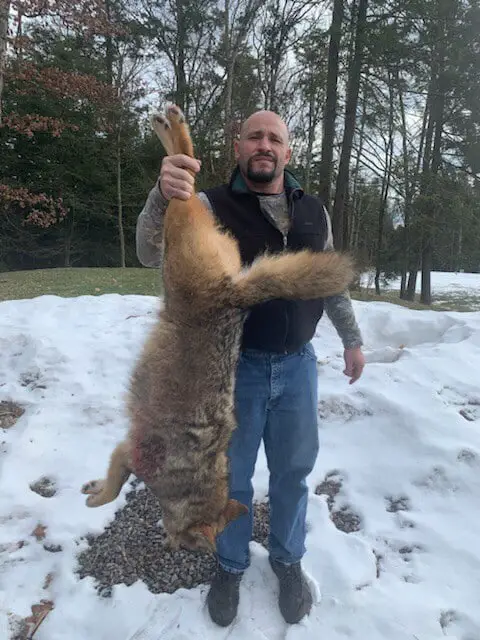
Photo Credit: Joseph Guastella.
Along the way, the eastern coyote could be temporarily distracted or become suspicious. If you quit 20 minutes into your stand, you may be at your next location before the first coyote to hear your call arrives.
The shortest eastern coyote stand should be no less than 45 minutes. Remember your call has to be heard by the coyote, catch and hold its attention, and last long enough for the coyote to appear.
Expect a lot of empty stands when you hunt eastern coyotes.
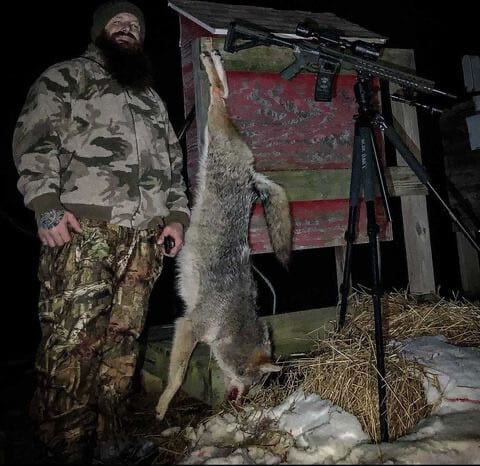
Photo Credit: Brian Scott
The eastern coyote hunter who takes more than ten coyotes a year is a local hero. In fact, many would-be eastern coyote hunters quit without even spotting one of these big dogs. So what separates a hero from a quitter? The ability to accept and endure an average of 24 empty stands for every 25 made.
There are ways a new eastern coyote hunter can greatly increase there odds. The first and most important is to be tenacious. Keep making stands, despite the empty, cold nights and windy wet days. A Persistant, dogged eastern coyote hunter will eventually score one of the true prizes of the predator hunting world
The second way to even up the odds is to get access to as much land as possible. Access to land means gaining permission. Permission comes to those who thoughtfully approach landowners before the season. Make getting access to new hunting locations a priority during your initial scouting efforts.
Hunt small areas and move to different stands at least a mile apart.
Bring a bigger gun when hunting eastern coyotes.
Using the minimum recommended kinetic energy (foot-pounds) of 10ft/lb per pound of coyote, using anything less than a .22-250 could result in many 50+ pound dogs requiring tracking.
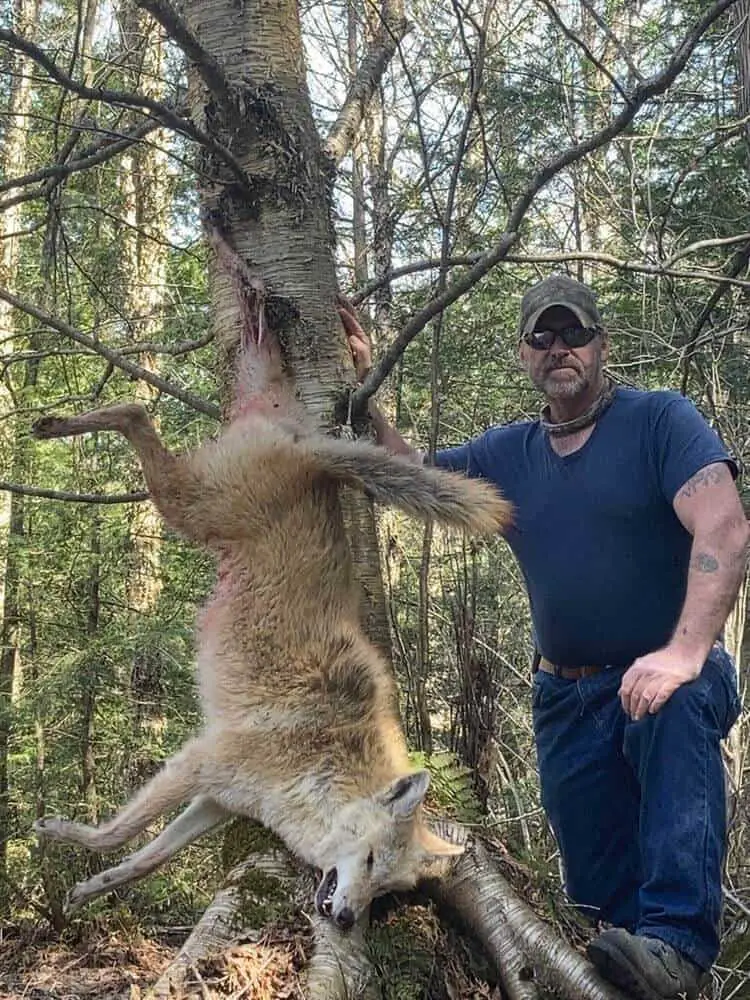
Pictured above: Robert Gonyaw of Vermont may use a 55gr .223 to take 52-pound eastern coyotes like this—but then he’s probably a better shooter than most.
With 60+ pound eastern coyotes being taken more often, and even the occasional 70pounder being reported, even the best shooters will need to reconsider the stopping power of their favorite rounds.
And eastern coyotes seem destined only to get larger and potentially more dangerous over time.
Related:
Are there eastern coyotes in California?
Let’s take a break right here, this article is too long without one.
There are no eastern coyotes in California, but Northern California has something we need more of in New York: Predator Hunting Couples.
Haley Tolerton and Anthony Fresquez like to hike up the higher elevations in the state’s high country and take on some unusually large western coyotes. They report coyotes in these locations are few and far between, but they get a few giants every season.
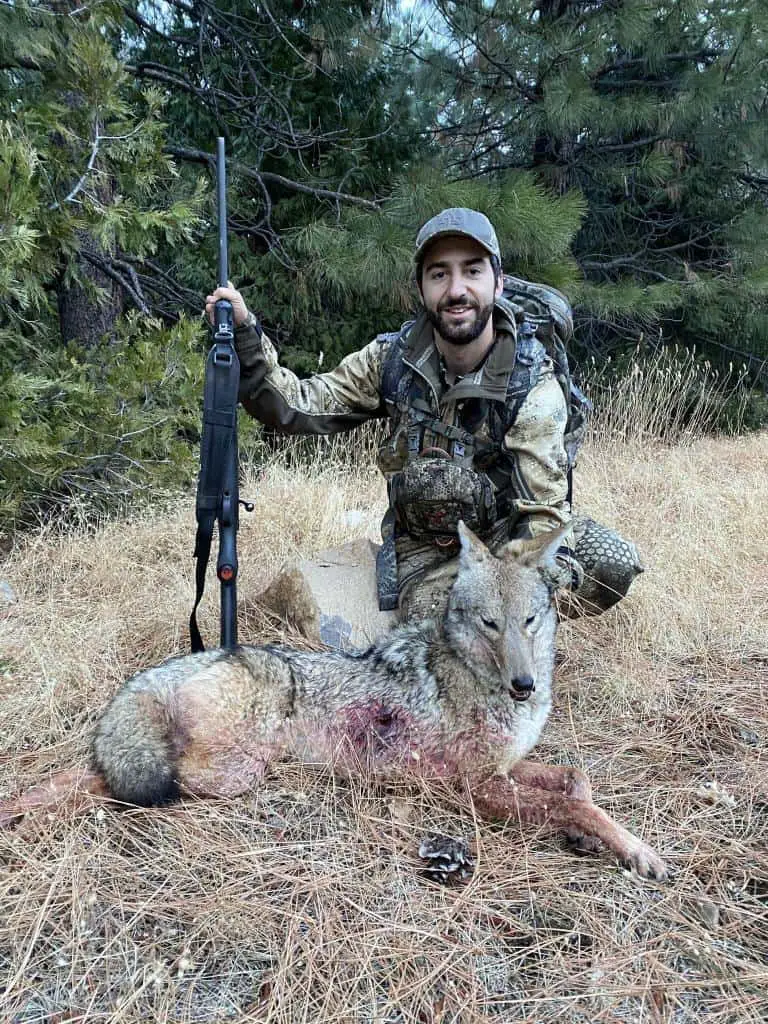
Yes, there are big dogs in California. But, you’ll have to travel the high country of Northern California to get them, like Mr. Fresquez does. He uses .270.
Photo Credit: Anthony Fresquez.
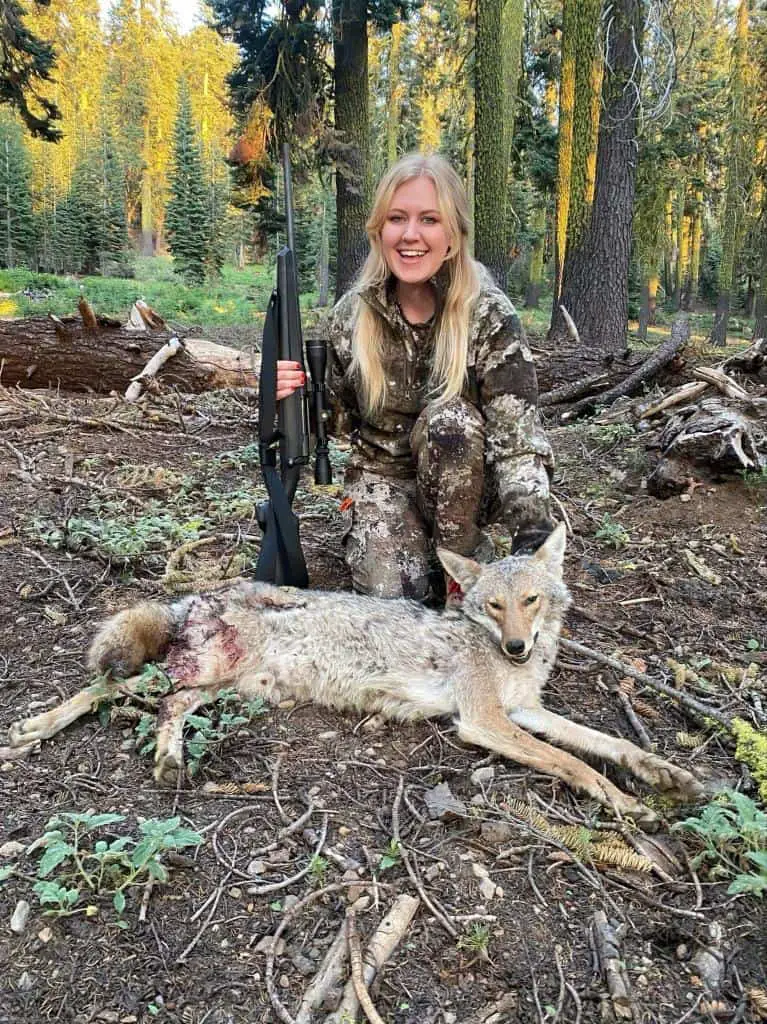
Haley Tolerton of Northern California drops her dogs with a 7mm.08.
Photo Credit: Haley Tolerton.
Break’s over! Get back East and back to the article—your spouse ain’t
Calling eastern coyotes.
Dedicated eastern coyote hunters, however, often pass on the occasional fox that appears. Regardless of your preference, it’s essential to realize that prey calls will bring in every type of predator, but coyote vocalizations will not.
And, if you use prey in distress sounds and shoot at a fox, you’ll probably have to move to another stand to get any chance of calling in a now-alerted coyote.
Choosing a caller for hunting eastern coyotes.
The new predator hunter has three types of callers to choose from. Most new hunters will let money decide for them, which can benefit them in the long run.
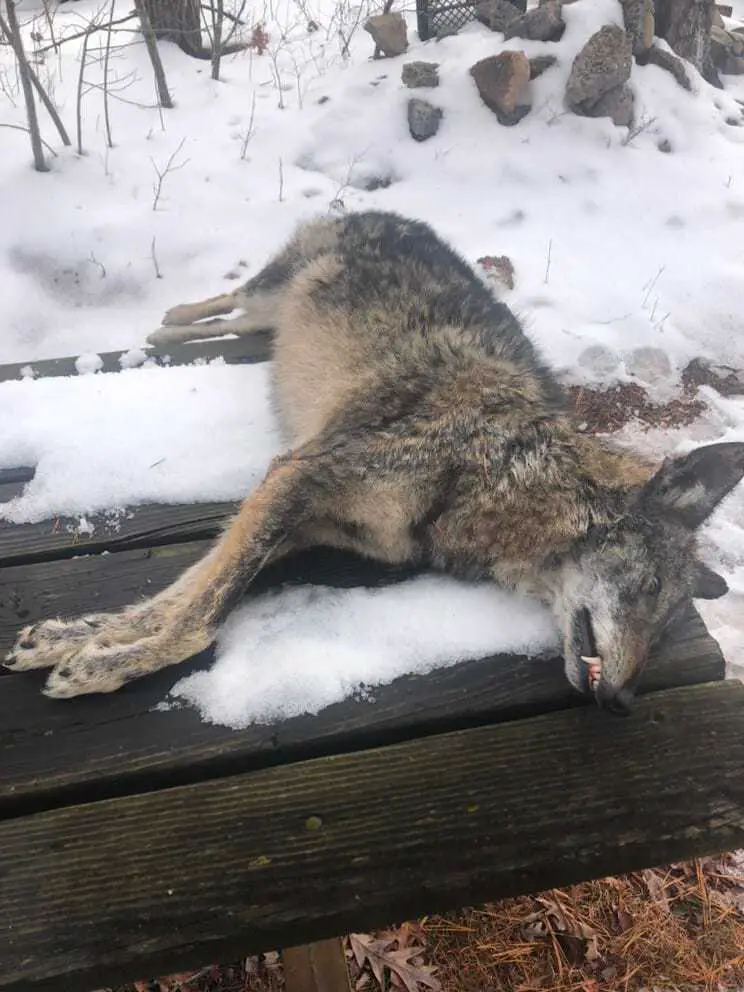
Squeeze bulbs.
I’m a big (HUGE) fan of the Primos Mouse Squeaker. At under $10, it’s the most effective and easiest to use caller on the market. Its small size doesn’t affect its volume; it’s perfect for the smaller lands eastern coyotes inhabit.
With a few one-handed squeezes, you can produce a virtual soundtrack mimicking a mouse under ever-increasing stress and terror. Shunned by many for its low price and tiny size, it remains a lifelike yet rarely heard sound that most predators find irresistible.
I never go afield without one (sitting in a coat pocket or taped to a shotgun) just in case my other callers fail. The primos mouse squeeze os also an excellent tool to stop a coyote before firing. A quick tap brings even a bolting dog to a complete stop out of pure curiosity.
Please note: I get a small commission (at no extra charge to you) if you use one of the product links I provide. Thanks for your support!
Closed reed calls.
When it comes to bringing eastern coyotes into close range using prey in distress, there’s just nothing better than a closed reed rabbit squealer. Perfect for one-handed operation for those who hunt alone, its simplicity, wide range of emotion, and adjustable volume make it the best type of caller for the money.
Yep, stage fright has probably kept you from buying one, and that’s a damn shame. However, with little more than 10 minutes of windshield time (practicing while driving alone in a vehicle), you can become a master with a closed reed call.
Hey, I know I can’t change your mind with a few short paragraphs, so check out my article on using the best closed reed caller here: https://thepredatorhunter.com/how-to-master-the-best-closed-reed-coyote-call/
There’s a quick tutorial/video there for you, made by Brian Rush himself.
And by best, I mean this one from rushcustomcallers.
Forget those slightly cheaper plastic callers and buy one made to last a lifetime.
Please note: I have no financial relationship with Mr. Rush. I don’t get a penny from him, but he provides this site with invaluable expertise. And his callers are the finest handmade tools an eastern coyote hunter can carry afield.
Interested in hunting fox at night? Check out my book! This one, I do have a financial interest in!
Open reed callers.
Harder to master, but an open-reed call offers you the ability to make dozens of sounds from one straightforward hand call. You can adjust the inflection, change the tone, and control the pitch. Plus, you have the ability to alter the tempo once you can observe the coyote’s responses.
Related: Brian Rush teaches how to use the open reed caller! https://thepredatorhunter.com/3-open-reed-coyote-calls-you-can-learn-now/
Diaphragm (mouth) calls.
These can be so hard to use; the only benefit to even trying to learn one is convincing your wife to let you buy an expensive e-caller.
But, if you have the time and patience, to practice and study videos detailing how to use an open reed coyote call, you’ll eventually get better at it.
Electronic callers for hunting eastern coyotes.
At first glance, an electronic caller solves all your problems. Of course, many come with every sound you will ever need, and a few from regions you’ll never hunt in, but that may be just different enough to work.
But there are two reasons to forego buying and using one; they are expensive, and you won’t learn as much about your target animal.
I’ve tried plenty of them; here’s the one I really like.
The best calls and sequences to use for hunting eastern coyotes.
Despite everything you have ever heard about the difficulties and challenges of eastern coyote hunting, calling them in is simple but not exactly easy. Whatever type of caller you choose, there are only two sounds that truly fascinate coyotes: prey and other coyotes.
Important tips for new eastern coyote hunters.
Listen, if you do everything else right—find where the coyotes live, slip in nice and quietly, and gauge the wind correctly—it doesn’t matter if you mangle your mouth call or cut short a howl mid-call on your electronic caller.
You’ll get better with practice, sure, but even those first few fumbled calls can bring a coyote in on your first night out. So whatever you do, do not get so frustrated as to be unprepared to take an unexpected shot.
One more tip, especially for the new predator hunter: The easiest way to get over your stage fright is to call and SCAN. Keep sweeping your target zone with that red light, IR scope, or thermal scope.
Related: https://thepredatorhunter.com/best-coyote-hunting-light-color/
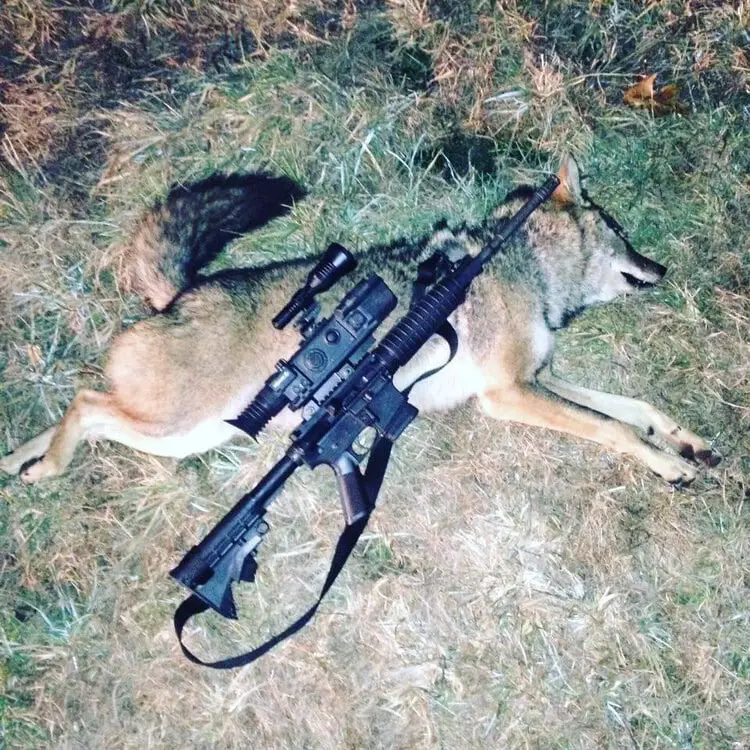
Photo Credit: Robert Fulk of Rockingham, VA. Mr. Fulk has all the gear for effective night hunting of eastern coyotes.
So what if you think that closed reed rabbit squeal sound you made sucked? Have you ever heard a real rabbit being torn to pieces? It’s brutal! The screams can be cut short, wail on for minutes. Then, just when you think it’s over, the poor rabbit starts screaming again, at twice the volume, and then drops to a whimper.
Stop worrying about the imagined quality of your sounds and call and SCAN. The coyotes will come. Focus on scanning because the only true judge of your calling skills (and the only one who can hear you) may already be staring straight at you. You’ll never spot him if you stop scanning for any reason.
The worst call to use when hunting eastern coyotes?
Well, if you watch enough videos or hunt with enough friends, you probably know the electronic sound of a dying rabbit is the first and only call most predator hunters use. True, it works, and you can’t train a coyote to stop coming to a free meal, but there’s one massive problem with it: It’s BORING.
Related: https://thepredatorhunter.com/coyote-hunting-the-truth-about-educated-coyotes/
Think about this; law enforcement has used dying rabbit sounds to end stand-offs. They convince armed, desperate criminals to throw down their weapons and surrender by playing it long enough.
How many first-time predator hunters make only one night’s worth of stands, playing only this call, before tiring of the damned sport forever? How many use this easy call for too long and end up “educating” themselves and believing all the coyotes around them have been overcalled?
Sure, go ahead and use it. Just don’t be “that predator hunter,” the one who only has one tool in their hunting kit. You’ll stop learning, stop having fun, and soon, stop hunting.
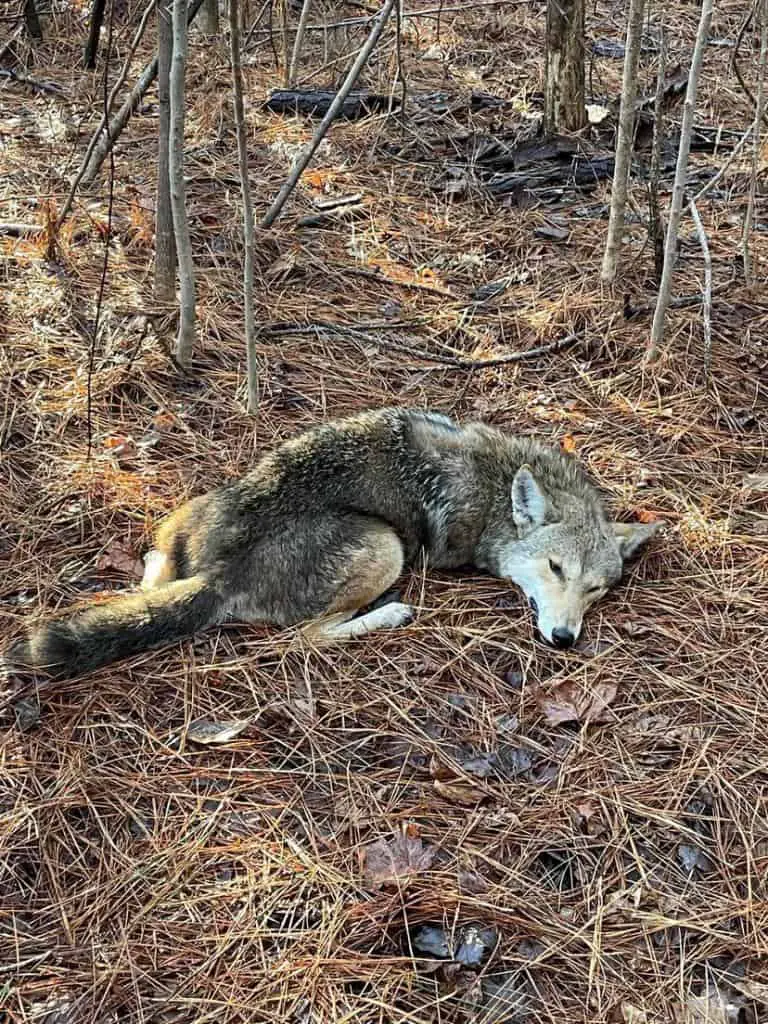
Photo Credit: Amos Adams. Mr. Adams took this big male eastern coyote in Virginia after just 13 minutes of perfect calling.
But, if you are still wondering, “What’s the worst call to use when hunting eastern coyotes?” It’s Gallus Gallus Domesticus. Coyotes may eat chickens (they sure like to eat mine), but my experience is they won’t come to the sound of a chicken for any reason.
Creating a perfect scenario when you hunt eastern coyotes
No matter what call you choose to use, try to make your entire sequence sound like an actual event. Prey in distress will not scream at full volume for twenty minutes. Coyotes will howl and then listen for a response, sometimes for 15-30 minutes. Add some emotion, volume changes, and even other sounds to your sequence to create the perfect scenario.
You’re trying to capture the coyote’s attention, make it curious, and continue to convince it a rabbit is dying or a trespassing coyote is invading its territory.
Related: https://thepredatorhunter.com/keep-them-interested-how-to-really-call-in-coyotes/.
Advertise a free meal: Prey sounds for hunting eastern coyotes.
No matter the season, the most significant percentage of prey found in the bellies of eastern coyotes remains the same—whitetail deer, followed by rodents (shrew, mice, voles), and finally rabbit. Since you will be targeting coyotes, we will use deer for our sample calling sequence, but it is universal for other types of prey.
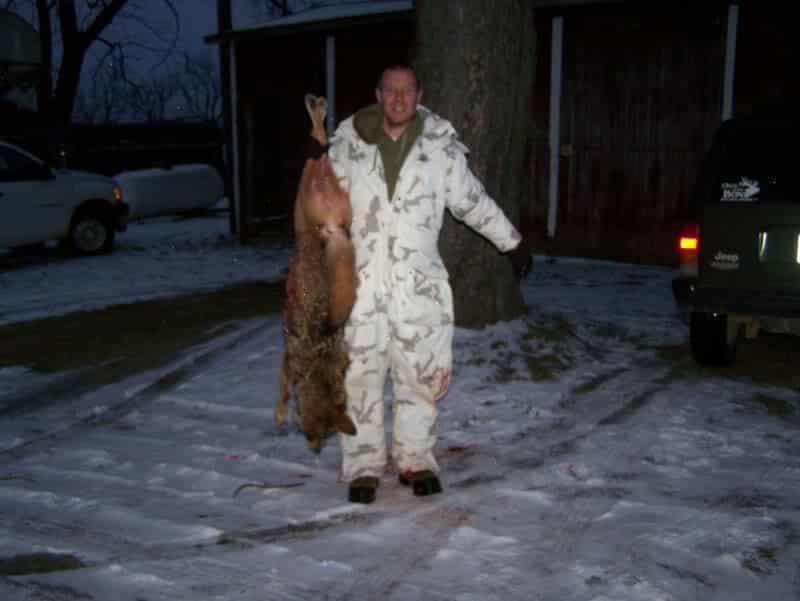
Photo Credit: Matt Myers. Mr. Myers brought this 50.3 lbs. coyote close enough to use a .204 Ruger on him.
Fawn in distress sequence
Pro tip: Always start a calling sequence after you have let the area “go quiet” by remaining still and silent for 15 minutes after reaching your stand, and start your first calling sequence at a lower volume to prevent scaring off any nearby coyotes.
Solo hunters: While many mouth/hand calls replicate fawn in distress sounds, I recommend you use an electronic caller instead. You’ve only got two hands, and one must be dedicated to scanning.
Begin with a faint series of mouse squeaks for 15-30 seconds while constantly scanning. If there’s a coyote nearby, it will show up either right away or within the next two minutes. If nothing happens, it’s time to switch to the fawn in distress call.
Start with a medium volume setting, and let the call run for about five minutes before stopping. Now comes the hard part, except for continuing to scan. You need to sit still and in total silence. (My article on keeping their interest).
A hungry eastern coyote won’t just stop coming if you stop broadcasting. They may, however, become wary if their potential target acts unnaturally.
Keep it realistic when hunting eastern coyotes.
After a 3-5 minute period of silence, start adding more volume and switching up your call duration and periods of silence. Have a little fun, but avoid patterns and excessive volume (in colder temps, that’s a great way to crack your speaker).
Once you’ve gone as loud as reasonable, reverse the process. In this manner, you allow the sound to reach the most distant predator possible and give it time to make its approach.
When you finish calling, spend another 10 minutes simply scanning. Any late arriving coyotes will know exactly where the call came from, and you’d be surprised how many show up after you’ve ridden off.
Intruder Alert: Coyote vocalizations.
To a resident eastern coyote, controlling their territory is the key to survival. Coyotes absolutely will not allow a non-family member to trespass their land. For nonresident coyotes, the search for a home and a mate is the first step to permanent residency and a chance for survival.
With that in mind, your best bet is to use a non-aggressive female interrogation howl as your first coyote vocalization of the stand. Of course, any resident (male or female) will react to your call as they would to any intruder. In addition, any male nonresident might consider this a chance to meet a potential mate.
While just the female interrogation howl may produce the desired response, try my favorite sequence below to multiply the odds of calling in a dog on a stand you are confident has coyotes on it. It’s the one I use when I will recording coyote activities and intend to spend a couple of hours on stand watching them interact.
Stranger in the night: My favorite calling sequence when hunting eastern coyotes.
You will be putting on a play designed to attract resident and nonresident coyotes that begins with a lonely female looking for a mate and ends with two coyotes having a nice loud rabbit dinner in someone else’s kitchen.
- Start with a series of 3- 4 female long howls (invitation or interrogation are also suitable) consisting of 2-3 howls followed by 2-3 minutes of silence.
- If you get no response, switch to a long male coyote howl. 1-2 long howls, followed by 2-3 minutes of silence. Keep repeating this sequence for 15 minutes. Note: Chances are, your hunt will end here with a coyote or two showing up. But they may hang back, barking and complaining, and not come in close enough for a good shot. Cheer up; you have just gotten started.
- Your next series of sounds will be any of the coyote pairs or coyote yips you can produce. Raise and lower your volume with each sequence, but stay within the medium to the loud range. Add a period of silence here and there, as you see fit, but the point here is to torment the hell out of the resident coyotes listening in. Note: Scanning will be vital. Expect the coyotes to circle the caller and make separate or simultaneous (though from different directions) approaches (as seen in the video above).
- Serve the meal, seal the deal. Do not give up if the coyotes seem to run away. They can appear and disappear several times during this long scenario. If you haven’t gotten a shot in yet, however, it’s time to serve dinner. Start playing any rabbit or fawn in distress call, crank up the volume and let it run. At this point, the coyotes who have been listening to your scenario are almost impossible to scare off. Trespassers have committed the ultimate crime, met a mate, and had a meal together on their land. They are now looking for a fight, and they will engage.
The best time to hunt eastern coyotes.
The most productive eastern coyote hunting occurs:
In the dark from dusk to dawn.
Catch them with empty bellies as they start their evening hunt for food or just before daybreak as they head home after a long night of fruitless searching.
Just before or after a storm.
Eastern coyotes know that traveling in storms is calorie-wasting nonsense. With most of their senses rendered useless, they’ll be very active as the storm approaches and then hunker down and wait it out once it arrives. The night before, a significant snowstorm can produce some fantastic responses to prey calls. After deep snow has had enough time to form a hardtop, expect the now famished coyotes to break cover and come running to that deer decoy or squalling rabbit.
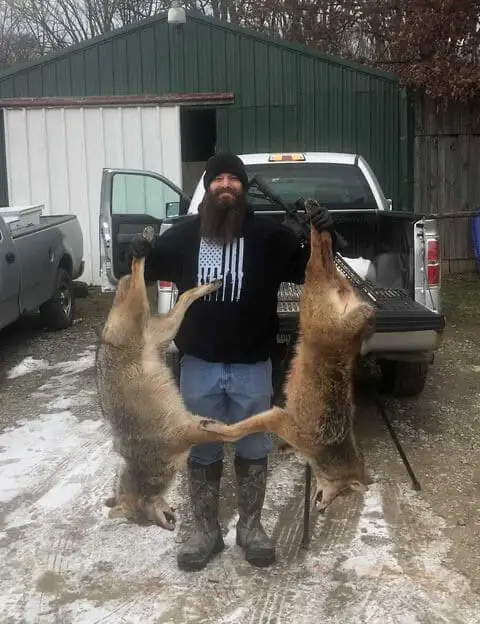
During up rearing season.
Find an active den in the summer, and hit it the first to hours after dawn.
During a deep freeze.
Eastern coyotes inhabit some of the coldest spots on the continent. Their food intake requirements leap up during sub-zero days just to remain still and generate body heat. After a week of brutally cold temperatures and being unable to dig rodents out of the frozen landscape, they’ll need that rabbit they hear out there more than ever.
Trust me; the conditions are perfect if your fingers are burning and you are carrying two extra sets of batteries.
Six fatal mistakes to avoid when you hunt eastern coyotes.
One: Don’t announce your presence.
Eastern coyotes don’t get as big as they do by being foolish. They are incredible hunters, quick learners, and elusive targets. Avoid making these mistakes if you want to have any hope of scoring a kill on a coyote over 50 pounds.Don’t announce your presence. Remain quiet at all times. Call into the wind. Keep your hand movements slow and reduce your body movements to a minimum. Related: https://thepredatorhunter.com/the-best-ways-to-beat-a-coyotes-amazing-senses/
Two: Know your yardage and use the lowest magnification possible.
Missing sucks, missing, and then struggling to reacquire the target sucks even worse.
Three: Aim for a dead right there coyote.
Shoot to kill the coyote right there. Learn the best place to shoot a coyote and only fire when you have the perfect shot. Related: https://thepredatorhunter.com/guaranteed-dirt-naps-best-place-to-shoot-a-coyote/
Four: Know how to tracks a wounded coyote.
Be prepared to track a wounded eastern coyote until you find it. Related: https://thepredatorhunter.com/how-to-track-a-wounded-coyote/
Five: Hunt your stand, do not haunt it.
If you skipped the scouting and keep getting dry stands, you are in the wrong spot. Do some real scouting and find a new location—if you don’t, you’ll stop predator hunting forever.
Six: Test gear at home, not in the field.
Test your gear and carry backups. Batteries die, remotes are hard to read without glasses, and magazines get dropped in the snow. Create a checklist, tryout your all your gear in the backyard, and remember: one is none, and two is one—if it’s critical, carry a spare.
Successfully hunting eastern coyotes.
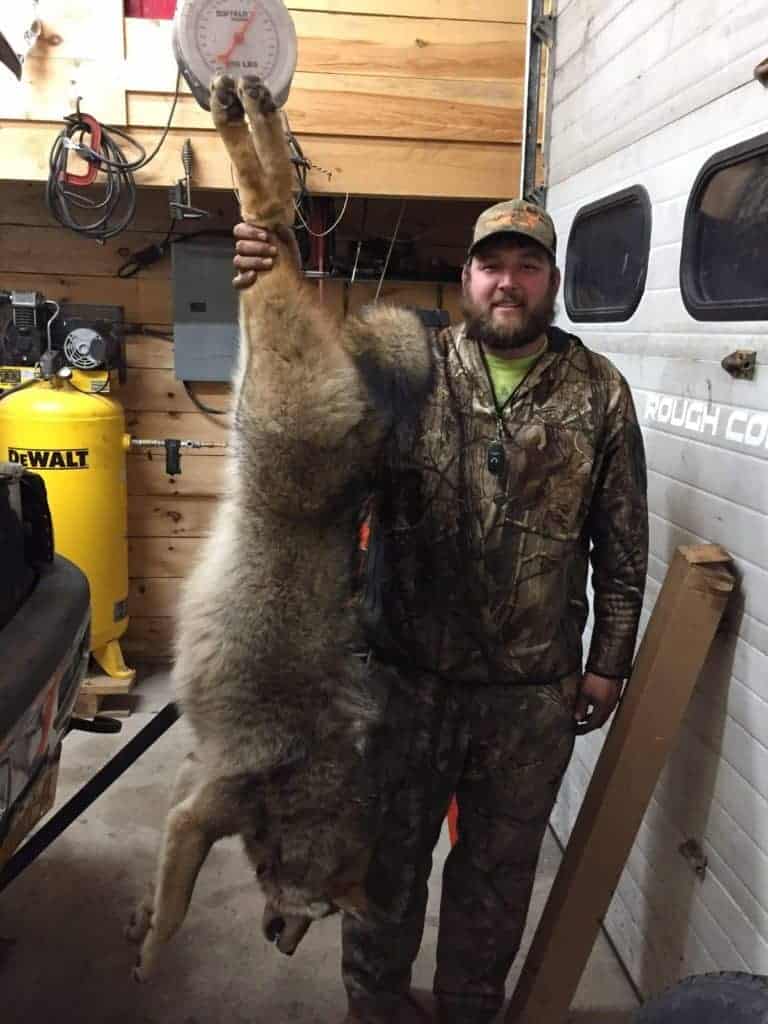
The great Lenny Coons with his 63-pound eastern coyote.
The keys to taking an eastern coyote so heavy you need a sled to bring it home are all noted above. All you need to add are tenacity, adaptability, a bit of experimentation, and a few trials of your own. There are some huge coyotes out there. So when you score your trophy, eastern coyote, let me know.

